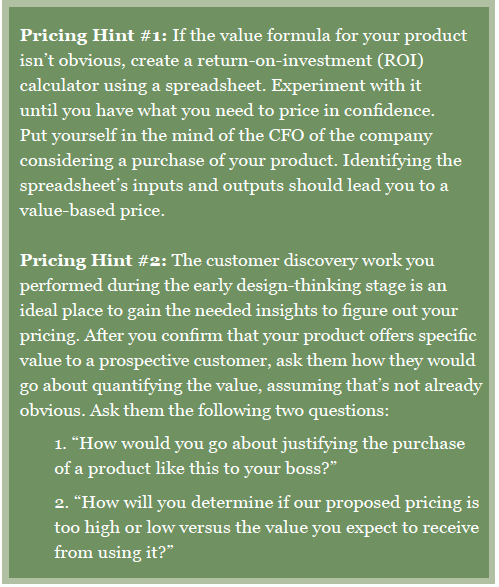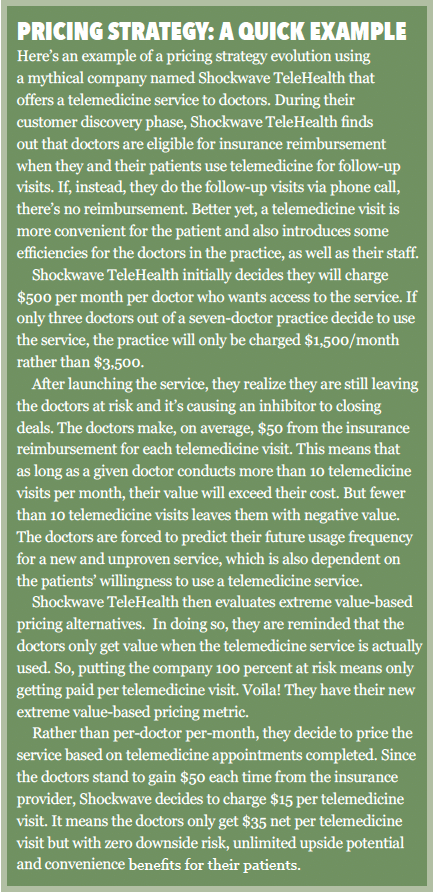Getting the Price Right

How to Establish the Right Pricing Strategy for Your Startup
A great product at the wrong price either leads to underperforming sales results or money left on the table. Pricing a product might initially seem easy, but it gets more complicated as the strategy process unfolds or as initial sales results point to a needed adjustment.
It is almost impossible to get pricing strategy right the first time. But starting with the right fundamentals makes it much easier to adjust and adapt fairly quickly. It is those fundamentals and a handful of tools that we will cover in this issue of Startup Success.
Pricing Metrics
There are numerous units of measure to choose from when pricing your product. These are your pricing metrics. With many products we purchase in our daily lives, the metric is obvious. For example, the fuel for our gas-powered vehicles is priced by volume (gallon, liter). The hotel room we rent is priced by usage (nights used). And when we go out to a movie with friends, we pay per user (one movie ticket per person).
In general, there are three broad options for the pricing metric:
- Per product
- Per user
- Per usage
In the tech world, the per-usage metric could mean a whole variety of things, including storage or network consumption, time used, or different types of functional actions taken.
Pricing Strategy Basics
Similar to pricing metrics, there are numerous different pricing strategies that can be deployed. When the perfect pricing metric and strategy come together, magic can happen.
In general, there are four broad options for pricing strategy.
- Value – This strategy optimizes the value the customer receives from using the product.
- Profit Margin – This strategy optimizes for a desired gross profit margin, given the cost to produce and deliver the product.
- Competition – This strategy contemplates the competitive forces that exist from similar products that are already priced by various competitors.
- Market Share – This strategy is similar to the Competition strategy but, more specifically, aligns with a desired market share for the company.
Whether they realize it or not, most companies actually employ a blending of multiple pricing strategies. They do this by starting with a primary strategy and then using one or more of the others either as a sanity check or to further optimize the final price. We’ll see how this works shortly.
Start with Value-Based Pricing
If your customers don’t conclude that the value of using your product exceeds the cost, they are very unlikely to buy it. And if you offer a subscription-based price, they might use your product for a short period of time but will later cancel (causing churn). Starting with a value-based pricing strategy will give you the best chance of both landing new customers and keeping them over time.
But in order to properly deploy value-based pricing, you must first clearly identify and characterize the value your customers gain from using your product. In fact, you will need enough specificity to set a price they will identify as clearly lower than the value they’ll receive.

Time to Blend
With your value-based price serving as a base, now it’s time for a sanity check and likely adjustments. You’ll do this using the other pricing strategies mentioned previously.
Profit Margin – If you’re lucky, you will end up with higher gross profit margins than needed. If not, then you can either accept the lower gross margin and offset somewhere else (lower expenses, improved CAC and CAC payback, etc.) or you can raise the price while knowing your customer value equation won’t be as attractive.
CAC refers to the cost to acquire a customer. CAC payback refers to how long it takes a company to recoup that customer acquisition cost.
Competition – If you’re lucky you will end up with a price that’s equal to or lower than equivalent competition. If not, then you can either accept the fact that the competition has an even better customer value equation or you can reduce your price to be more in line.
Market Share – This method of blending is more philosophical than economical. In fact, if during the Competition evaluation you discover that your value-based price is lower than the competition, then you also have a built-in market share pricing strategy. If you really want to get aggressive on gaining market share, you could lower the price even further. It may also become obvious that the market share and profit margin strategies are in conflict with each other.
Extreme Value Pricing
Now that you understand the exercise, including the importance of starting with a price that equates to customer value, let’s take the exercise to an extreme. The concept here is to put the company 100 percent at risk with regard to monetizing your product. In other words, if the customer doesn’t get any value, you get ZERO. If the customer gets partial value, you get partial payment. If they get extreme value, you get extreme payment. In this way, you can ensure that you and your customer are perfectly aligned.
This is what contingency or success fee pricing is all about. Some employment recruiters will accept an engagement that calls for a success fee. If they don’t bring you a job candidate that ends up getting hired and stays employed with you for at least 90 days, they don’t get paid for their work. But if they do have success against these criteria, you pay them 25 percent of the new employee’s annual salary (or whatever their contingency rate is). Civil trial lawyers sometimes do the same thing when working with a client to sue another party.
If you were to only get paid if your customer receives value, what would that look like? What would the pricing metric be and how much would you charge per metric unit?
When Value Is Tied to Avoidance
Much of this article is centered on customer value and most of the examples given relate to some measurable improvement. But some companies have value propositions that relate to a form of avoidance—in other words, avoiding some negative outcome or dramatically reducing the odds of some negative outcome. In these cases, it can be much harder to find a viable value-based pricing strategy and nearly impossible to take it to the extreme.
An example is a company with technology that helps reduce several forms of violent crime. An extreme value-based pricing strategy would compensate the company only if the rate of violent crime is reduced. This requires a benchmark to serve as a starting point. In other words, a city might currently experience a monthly violent crime rate of 1:500,000 citizens. The company could decide to charge a certain amount per month per 1 percent reduction in the violent crime rate. This might seem straightforward, but the oversimplification glosses over a few challenges. Below are some examples:
- What if other measures are taken at the same time to improve on the benchmark? The product could be achieving its results but other unrelated actions are having a negative impact and it’s causing the company to not get paid.
- How valid is the benchmark and how possible is it to measure improvements over time? Who is responsible for conducting the measurements?
- Once considerable improvement has been achieved, the opportunity for continued improvement diminishes, which means continue revenue diminishes.

Sanity Check
Sometimes we go through the extreme value-based pricing exercise but due to the extreme risk it puts on the cash burn rate of the company, we aren’t able to swing the pendulum quite that far. That’s OK. It is the learning from the exercise that you are looking for. Understanding the absolute, ideal value-based price from the customer’s perspective will surely help you in the long run, because you will better know how the customer is thinking when they decide about purchasing. You might better be able to create an ROI calculator that you give to them as part of your sales process.
Perhaps you start out like Shockwave TeleHealth (see “Pricing Strategy: A Quick Example”), but continue working on various business model optimizations that allow you to migrate towards a more extreme value-based pricing strategy and metric. If you never go through the exercise of determining the most extreme value-based price, you will be flying without full and clear vision.
Freemium and Free Trial Offers
Freemium and free trial offerings aren’t as much pricing strategies as customer acquisition strategies. But just as money-back guarantees, success fees, and contingency pricing serve as ways to reduce risk on behalf of the customer, freemium and free trial offers can accomplish the same.
The customer gets a period of time to experience the value of the product without a financial commitment. In the case of a freemium offer, they aren’t getting the full functionality, so the key is to make sure the customer can mentally extrapolate the incremental value from the paid features to cause them to make that jump (conversion). In the case of the free trial, they’re getting full functionality, but for a limited amount of time.
Companies that don’t have an ideal value-based pricing metric or can’t go to the extreme as described here, and that are still finding customers hesitant to take the risk, should consider a freemium or free trial offer to help reduce that risk.
. . . .
Pricing strategy is an iterative exercise that might never end for your company. That doesn’t mean you’ll whipsaw yourself and your customers with different pricing metrics and methodologies every year. Rather, it likely means that as your product, company, competition, and market evolve, so will your pricing strategy. Make sure to keep your eyes and ears open while including various KPIs and associated metrics on your dashboard to alert you when things change that might relate to your pricing strategy.






